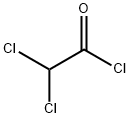다이클로로아세틸 염화물 C화학적 특성, 용도, 생산
화학적 성질
Dichloroacetyl chloride (DCAC) is a colourless to light yellow fuming liquid with an acrid, penetrating odor. It is irritating to the eyes and mucous membranes (HSDB 2003b). DCAC is insoluble in water, but decomposes quickly to form HCl and dichloroacetic acid (t1/2 of hydrolysis of 0.0023 seconds in water at 25°C, and 0.2 seconds in 89.1:10.9 water-acetone at -20°C (Prager et al. 2001, Ugi and Beck 1961).
용도
Dichloroacetyl Chloride is a reagent used in the synthesis of substituted benzothiazoles exhibiting antitumor and anticancer activity.
정의
ChEBI: Dichloroacetyl chloride is the acyl chloride obtained by displacement of the hydroxy group of dichloroacetic acid by chloride. It has a role as a hapten. It derives from a dichloroacetic acid.
제조 방법
Dichloroacetyl chloride can be synthesized by the reaction of dichloroacetic acid and chlorosulfonic acid. Or from the oxidation of trichloroethylene. Trichloroethylene and azobisisobutyronitrile (catalyst) were heated to 100°C, and oxygen was introduced to react under 0.6MPa pressure, maintaining the oil bath temperature at 110°C, and reacted for 10h, The product dichloroacetyl chloride is distilled off under normal pressure.
일반 설명
Dichloroacetyl chloride is a colorless liquid with a pungent odor. Flash point 151°F Boiling point 107-108°F. Vapors are irritating to the eyes and mucous membranes. Corrosive to metals and tissue.
공기와 물의 반응
Fumes in air. Decomposed by water to dichloroacetic acid and hydrochloric acid, both corrosive, with release of heat. (NIP).
반응 프로필
Solutions in acetone are stable for less than two hours and fresh solution should be prepared before each use (NIP). May react vigorously or explosively if mixed with diisopropyl ether or other ethers in the presence of trace amounts of metal salts [J. Haz. Mat., 1981, 4, 291].
건강위험
TOXIC; inhalation, ingestion or contact (skin, eyes) with vapors, dusts or substance may cause severe injury, burns or death. Contact with molten substance may cause severe burns to skin and eyes. Reaction with water or moist air will release toxic, corrosive or flammable gases. Reaction with water may generate much heat that will increase the concentration of fumes in the air. Fire will produce irritating, corrosive and/or toxic gases. Runoff from fire control or dilution water may be corrosive and/or toxic and cause pollution.
화재위험
Combustible material: may burn but does not ignite readily. Substance will react with water (some violently) releasing flammable, toxic or corrosive gases and runoff. When heated, vapors may form explosive mixtures with air: indoors, outdoors and sewers explosion hazards. Most vapors are heavier than air. They will spread along ground and collect in low or confined areas (sewers, basements, tanks). Vapors may travel to source of ignition and flash back. Contact with metals may evolve flammable hydrogen gas. Containers may explode when heated or if contaminated with water.
Safety Profile
Questionable
carcinogen with experimental tumorigenic data. Moderately toxic by ingestion,
inhalation, and skin contact. Corrosive to
the skin, eyes, and mucous membranes.
Combustible when exposed to heat or
flame. When heated to decomposition it
emits toxic fumes of Cl-. See also
CHLORIDES.
다이클로로아세틸 염화물 준비 용품 및 원자재
원자재
준비 용품









